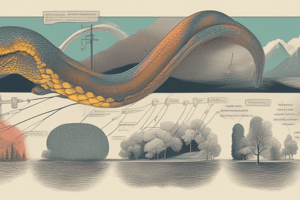Podcast
Questions and Answers
Explain the concept of mutability in the context of lists in Python programming.
Explain the concept of mutability in the context of lists in Python programming.
Mutability refers to the ability of an object to be changed after it has been created. In the context of lists in Python, mutability means that the elements of a list can be modified, added, or removed after the list has been created. This is in contrast to immutable objects, such as tuples, where the elements cannot be changed after creation.
How are dictionaries different from lists and tuples in Python?
How are dictionaries different from lists and tuples in Python?
Dictionaries in Python are unordered collections of data that use key-value pairs to store information, unlike lists and tuples which use indices to store elements. Additionally, dictionaries are mutable, meaning their elements can be changed after creation, and they do not allow duplicate keys.
What are the differences between a list and a tuple in Python?
What are the differences between a list and a tuple in Python?
A list is a mutable data type in Python, meaning its elements can be changed, added, or removed after creation. On the other hand, a tuple is an immutable data type, and its elements cannot be modified after creation. Additionally, lists are defined using square brackets [], while tuples are defined using parentheses ().
Explain the concept of function composition in Python.
Explain the concept of function composition in Python.
What are the key differences between local and global scope in Python functions?
What are the key differences between local and global scope in Python functions?
Flashcards are hidden until you start studying
Study Notes
Introduction to Python
- Python is a programming language that can be installed and used for various applications.
Data Types
- Int: a whole number, e.g., 1, 2, 3, etc.
- Float: a decimal number, e.g., 3.14, -0.5, etc.
- Boolean: a logical value, either True or False.
- String: a sequence of characters, e.g., "hello", 'hello', etc.
Lists
- A list is a collection of items that can be of different data types.
- List Operations: indexing, slicing, concatenation, repetition, and membership testing.
- List Slices: a subset of a list, e.g.,
my_list[1:3]. - List Methods:
append,insert,remove,sort, andreverse. - List Loop: iterating over a list using a for loop.
- Mutability: lists can be modified after creation.
- Aliasing: assigning a list to another variable, both variables point to the same list.
- Cloning Lists: creating a copy of a list using slicing or the
copy()method. - List Parameters: passing a list as an argument to a function.
Tuples
- A tuple is an immutable collection of items.
- Tuple Assignment: assigning multiple values to multiple variables.
- Tuple as Return Value: a function can return multiple values as a tuple.
- Tuple Methods:
indexandcount.
Dictionaries
- A dictionary is an unordered collection of key-value pairs.
- Dictionary Operations: accessing and modifying values using keys.
- Dictionary Methods:
keys,values,items, andget.
Control Flow
- Conditionals: using Boolean values and operators to make decisions.
- Conditional Statements:
if,if-else, andif-elif-else. - Iterations: using
forandwhileloops. - Break Statement: exiting a loop prematurely.
- Continue Statement: skipping to the next iteration.
- Functions: reusable blocks of code that take arguments and return values.
- Pass Keyword: a placeholder when a statement is required.
- Flow of Execution: the order in which code is executed.
Advanced Functions
- Fruitful Functions: functions that return values.
- Local and Global Scope: variable scope in functions.
- Function Composition: combining functions to create new functions.
- Recursion: a function that calls itself.
- Lambda Functions: small anonymous functions.
- Map, Filter, and Reduce: higher-order functions for data processing.
- Basic Data Type Comprehensions: concise ways to create lists, dictionaries, and sets.
Python Arrays
- Creating an Array: using the
arraymodule. - Accessing Elements: using indexing and slicing.
- Array Methods:
append,insert,remove, andsort.
Studying That Suits You
Use AI to generate personalized quizzes and flashcards to suit your learning preferences.




